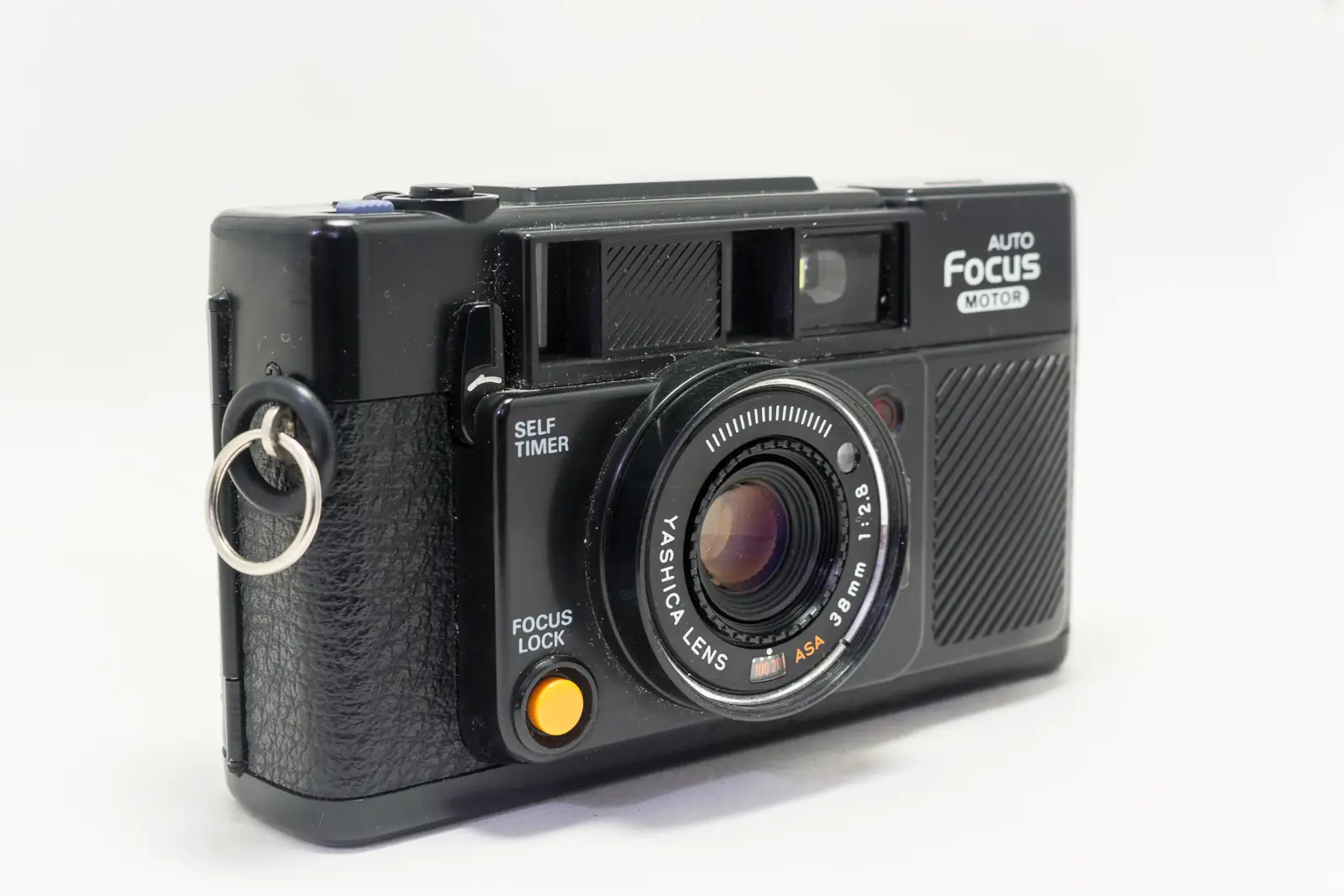The Yashica Auto Focus Motor. I’d never heard of it before finding one in a local charity shop, and for a mere £8 including original strap, case and manual, I thought it was worth a go. Delighted to discover that it worked perfectly, some ambivalence still remained due to its awkward looks, noises (more on that later) and name; no alphanumeric codes like the greats here, just a description of its one main feature: Auto Focus Motor. It also lacks the magical T* designation on the lens which has made later Yashica iterations so sought after. So why do I like it so much?

First, a quick overview: launched in 1981, this is an auto-everything camera, equipped with a 38mm f/2.8 lens, a film speed scale going from ISO 25 to 400, and a very-satisfying-to-pop-up flash unit. The only room for creative input – aside from framing and firing – is manually selecting the ISO. It also has a focus lock button for those times when the subject isn’t bang in the middle of the frame, along with a focus scale window to confirm what it’s focused on.
In low light, a half-press of the shutter release triggers a warning light in the viewfinder to suggest using flash (with the front covered, this also doubles up as the ‘battery check’ function). It’s not compact in the way that some of its peers are, but it’s small enough, and I actually quite like the reassuring heft of the thing. The viewfinder has parallax lines, there’s a tripod mount and of course a shutter lock button. And that’s about it.

In use, one of the most noticeable things is the noise. That auto focus motor, combined with the film advance, makes a terrific racket. This is certainly not a street photographer’s camera, unless you want everyone on that street to be unequivocally alerted to the fact that you just took a photo. Sounding like a mechanised bugle call, it announces your presence with every shot.
Then there’s how it looks: every button is decked out in a bold colour, reminiscent of a child’s toy that might have a ‘try me!’ label next to it on the packaging. As it happens, each button is indeed labelled to make its function absolutely clear. Instead of a lens cap, this has a plastic front plate which clips over the front of the camera, clearly a few evolutionary steps behind the advent of integrated sliding covers.

All of this adds up to a camera that is the antithesis of the slick, compact, high-end camera of some of its contemporaries. Accessible rather than esoteric, simple and utterly non-pretentious, it’s as if the splashes of colour are an attempt at friendliness; it goes out of its way to dispel any misconceptions that this is a professional tool. This is the opposite of the type of much-coveted camera we all want then, but what do we really want?
This is a camera where there is little temptation to spend more time taking photos of it than with it, and I’m happy to take it anywhere without being anxious about loss or breakage. I love that I have the option to manually change the ISO on a shot by shot basis (yes, you can hack DX coding, but it’s a bit of a faff). I’d love the scale to go one more stop to 800, but then I suppose it’d be a different kind of camera. I also love that it takes AA batteries and isn’t part of that CR123 generation. I like the lens too: at f/2.8 it’s relatively fast and I’ve found it to be sharp enough. It’s got nothing on the T series lenses (I am reliably informed) and it vignettes like no one’s business, but for me this only adds to its point-n-shoot charm. This is, in its own way, a perfect distraction-free camera that provides an opportunity to keep things simple.

That is to say, having everything automated can sometimes feel severely limiting; at other times it is entirely liberating. I love shooting film, but so often I find myself becoming obsessively preoccupied with taking independent meter readings before ensuring focus is spot on and then checking that everything’s ready to go on my ‘vintage’ (read ‘old and crumbling’) gear. Most of the time, I really enjoy this slow and methodical process, but every now and then it’s refreshing to be able to just see what you want to capture and immediately react, without the temptation to over-analyse, second-guess, and ultimately miss the moment.

These frames were taken on expired (hence the graininess) Kodak Ultramax during a trip to Turkey’s Mediterranean coast. If you’d like to see more images taken with this camera then you can find me on Instagram: @michaelraven_
Share this post:









Comments
Terry B on Yashica Auto Focus Motor Review and Notes – By Michael Raven
Comment posted: 02/05/2019
It's a little odd that the body is not emblazoned with the Yashica name, only the lens. So I rather suspect that the camera was made by one of the few manufacturers, possibly Cosina, who provided anonymous bodies, even though the vast majority would have been sold under better known camera names. Perhaps, but who knows, Yashica wanted it known that they were responsible for the lens, and going by your results, not a bad decision by them.
Comment posted: 02/05/2019
Comment posted: 02/05/2019
Dominique Pierre-Nina on Yashica Auto Focus Motor Review and Notes – By Michael Raven
Comment posted: 02/05/2019
Faraz on Yashica Auto Focus Motor Review and Notes – By Michael Raven
Comment posted: 02/05/2019
Comment posted: 02/05/2019
Terry B on Yashica Auto Focus Motor Review and Notes – By Michael Raven
Comment posted: 02/05/2019
Gorpalm on Yashica Auto Focus Motor Review and Notes – By Michael Raven
Comment posted: 03/05/2019
Comment posted: 03/05/2019
Comment posted: 03/05/2019
Comment posted: 03/05/2019
Darrin on Yashica Auto Focus Motor Review and Notes – By Michael Raven
Comment posted: 27/09/2019
with manuals and two screw on lenses wide angle and telephoto I have yet to shoot with it was almost tempted to just flip it but youri mages will have me throw a roll in and see what comes out nice pics
Comment posted: 27/09/2019
Kenneth Anderson on Yashica Auto Focus Motor Review and Notes – By Michael Raven
Comment posted: 17/09/2020
Nicolas Sanchez on Yashica Auto Focus Motor Review and Notes – By Michael Raven
Comment posted: 10/09/2021
Comment posted: 10/09/2021
Daniel Morales on Yashica Auto Focus Motor Review and Notes – By Michael Raven
Comment posted: 08/08/2022
How To Autofocus In Video Mode Nikon D90 – Mecam.me on Yashica Auto Focus Motor Review and Notes – By Michael Raven
Comment posted: 12/11/2022
The Nikon 70-200 VR’s Side Buttons – Mecam.me on Yashica Auto Focus Motor Review and Notes – By Michael Raven
Comment posted: 05/12/2022
Nikon’s G-Series AF-S Lenses – A New Breed Of Fast Sharp And Versatile Lenses – Mecam.me on Yashica Auto Focus Motor Review and Notes – By Michael Raven
Comment posted: 03/01/2023